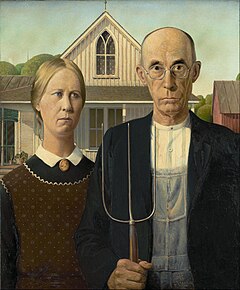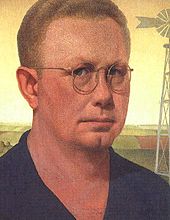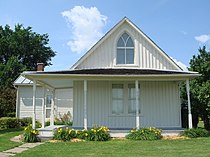Make America Rake Again American Gothic
| American Gothic | |
|---|---|
 | |
| Artist | Grant Forest |
| Year | 1930 |
| Type | Oil on beaverboard |
| Dimensions | 78 cm × 65.3 cm (xxx+ 3⁄four in ×25+ three⁄four in) |
| Location | Fine art Institute of Chicago |
American Gothic is a 1930 painting by Grant Wood in the collection of the Fine art Institute of Chicago. Wood was inspired to paint what is now known as the American Gothic Firm in Eldon, Iowa, forth with "the kind of people [he] fancied should live in that house". It depicts a farmer standing beside his daughter – often mistakenly assumed to be his wife.[1] [2] The painting's name is a word play on the house'southward architectural style, Carpenter Gothic.
The figures were modeled by Forest'south sister Nan Wood Graham and their dentist Dr. Byron McKeeby. The woman is dressed in a colonial print apron evoking 20th-century rural Americana while the man is adorned in overalls covered by a conform jacket and carries a pitchfork. The plants on the porch of the firm are mother in law's natural language and beefsteak begonia, which also appear in Wood's 1929 portrait of his mother, Woman with Plants.[3]
American Gothic is 1 of the well-nigh familiar images of 20th-century American art and has been widely parodied in American popular civilization.[i] [4] From 2016 to 2017, the painting was displayed in Paris at the Musée de l'Orangerie and in London at the Royal Academy of Arts in its first showings outside the United States.[v] [vi] [7]
Cosmos [edit]

In August 1930, Grant Wood, an American painter with European training, was driven around Eldon, Iowa, past a young local painter named John Sharp. Looking for inspiration, he noticed the Dibble Business firm, a small white firm congenital in the Carpenter Gothic architectural mode.[8] Abrupt'south blood brother suggested in 1973 that it was on this drive that Forest first sketched the house on the dorsum of an envelope. Woods's earliest biographer, Darrell Garwood, noted that Wood "thought it a course of borrowed pretentiousness, a structural absurdity, to put a Gothic-style window in such a flimsy frame house".[9]


At the time, Wood classified it as ane of the "cardboardy frame houses on Iowa farms" and considered information technology "very paintable".[ten] After obtaining permission from the business firm'southward owners, Selma Jones-Johnston and her family, Wood made a sketch the next mean solar day in oil paint on paperboard from the front end yard. This sketch depicted a steeper roof and a longer window with a more pronounced ogive than on the actual business firm – features which eventually adorned the concluding work.
Woods decided to paint the house along with, in his words, "the kind of people [he] fancied should live in that house".[one] He recruited his sister, Nan (1899–1990), to be the model for the girl, dressing her in a colonial print apron mimicking 20th-century rural Americana. While preparing for the painting, Wood requested that she brand the apron herself and include rickrack trim to improve reflect the time period. Unfortunately rickrack was no longer available in stores, and so Nan removed trim from their mother Hattie'southward old dresses to employ to the apron instead.[11] The model for the father was the Wood family's dentist,[12] Dr. Byron McKeeby (1867–1950) from Cedar Rapids, Iowa.[13] [14] Nan told people that her brother had envisioned the pair as father and daughter, non husband and wife, which Wood himself confirmed in his letter of the alphabet to a Mrs. Nellie Sudduth in 1941: "The prim lady with him is his grown-up girl."[1] [15]
Elements of the painting stress the vertical that is associated with Gothic architecture. The upright, three-pronged pitchfork is echoed in the stitching of the human'due south overalls and shirt, the Gothic pointed-arch window of the business firm under the steeped roof, and the construction of the man'due south confront.[16] However, Forest did not add figures to his sketch until he returned to his studio in Cedar Rapids.[17] Moreover, he would non return to Eldon again, although he did request a photo of the home to consummate his painting.[viii]
Reception and interpretation [edit]
Forest entered the painting in a contest at the Art Institute of Chicago. Ane approximate deemed it a "comic valentine", but a museum patron persuaded the jury to laurels the painting the bronze medal and a $300 greenbacks prize.[18] The same patron also persuaded the Art Establish to purchase the painting, and it remains function of the Chicago museum's collection.[2] The prototype presently began to be reproduced in newspapers, first by the Chicago Evening Post, and then in New York, Boston, Kansas Metropolis, and Indianapolis. Yet, when the epitome finally appeared in the Cedar Rapids Gazette, at that place was a backfire. Iowans were furious at their depiction as "pinched, grim-faced, puritanical Bible-thumpers".[nineteen] Wood protested, saying that he had non painted a caricature of Iowans but a delineation of his appreciation, stating "I had to go to France to appreciate Iowa."[12] In a 1941 letter of the alphabet, Wood said that, "In general, I accept found, the people who resent the painting are those who feel that they themselves resemble the portrayal."[20]
Art critics who had favorable opinions about the painting, such as Gertrude Stein and Christopher Morley, similarly assumed the painting was meant to exist a satire of rural small-boondocks life. It was thus seen equally office of the trend toward increasingly critical depictions of rural America along the lines of, in literature, Sherwood Anderson'southward 1919 novel Winesburg, Ohio, Sinclair Lewis'due south 1920 Principal Street, and Carl Van Vechten'south 1924 The Tattooed Countess.[1]
Nonetheless, with the deepening of the Smashing Depression not besides long after the painting was made, American Gothic came to be seen as a depiction of the steadfast American pioneer spirit. Woods assisted this interpretive transition past renouncing his bohemian youth in Paris and grouping himself with populist Midwestern painters such as John Steuart Curry and Thomas Hart Benton, who revolted confronting the authorization of Due east Declension fine art circles. Wood was quoted in this flow as stating, "All the skilful ideas I've ever had came to me while I was milking a cow."[1] American fine art historian Wanda Thousand. Corn insists that Wood was not painting a modern couple, but rather one of the by, pointing to the fact that Wood directed the models to habiliment old-fashioned clothing which he found inspiration for past consulting his family photo anthology. Wood even posed the figures in a manner that resembled long-exposure photographs of Midwestern families that dated before Earth War I.[21]
In 2005, art historian Sue Taylor suggested that the figures in the portrait may actually represent Wood'southward parents. She claimed that due to Wood'southward father passing abroad when Forest was merely 10 years old, Wood did not develop a shut relationship with him but noted that he did spend the remainder of his life very closely attached to his mother. She theorizes that Wood may have developed an Oedipus complex and subconsciously expressed that in the painting. Taylor cites the lack of warmth betwixt the two figures equally well as Wood'southward classification of them as "father and daughter" was a mode for Wood to remove any sexual connotation and so that Woods wouldn't take to confront his own fears and insecurities. Taylor likewise points out similarities between other portraits of Wood's mother and the woman in American Gothic, including the brooch that she wears. [22]
Fine art historian Tripp Evans interpreted it in 2010 every bit an "erstwhile-fashioned mourning portrait ... Tellingly, the curtains hanging in the windows of the house, both upstairs and down, are pulled airtight in the center of the day, a mourning custom in Victorian America. The woman wears a black clothes beneath her apron, and glances away as if property back tears. 1 imagines she is grieving for the man abreast her." Wood had been only 10 when his father died, and afterwards he lived for a decade "to a higher place a garage reserved for hearses", then death was probably on his mind.[23]
In 2019, civilization writer Kelly Grovier described the painting as a portrait of Pluto and Proserpina, the Roman gods of the underworld (a comparison made earlier by American writer Guy Davenport in his analysis of the painting in a 1978 lecture, "The Geography of the Imagination" [24].) Grovier suggests the modest globe on the conditions vane at the very top of the painting represents the dwarf planet Pluto (the planet was famously discovered in 1930 around the time of the painting'south creation). Grovier interprets the pitchfork-wielding farmer as the guardian of the gates of hell, Pluto, and points to the woman'southward cameo brooch, containing a classical representation of the mythological goddess, Proserpina, and the dangling strand of hair past the adult female's right ear as representing the ravishing in the goddess's myth.[25]
Parodies and other references [edit]
The Low-era agreement of the painting every bit depicting an authentically American scene prompted the outset well-known parody, a 1942 photo by Gordon Parks of cleaning woman Ella Watson, shot in Washington, D.C.[i]
American Gothic is a oftentimes parodied image. It has been lampooned in Broadway shows such every bit The Music Man, movies such as The Rocky Horror Moving picture Show, and television shows such as Green Acres (in the final scene of the opening credits), The Dick Van Dyke Bear witness ("The Masterpiece" episode), and the SpongeBob SquarePants episode "FarmerBob". Information technology has also been parodied in marketing campaigns, pornography, and by couples who recreate the image photographically past facing a photographic camera in the aforementioned way, 1 of them holding a pitchfork or other object in its place.[i] [4] The painting famously appears in the opening titles of the television prove Desperate Housewives (2004–2012).[26] The couple from the painting was also recreated in the HBO drama Oz during one of the show's monologue segments in the episode 'A Town Without Pity' during the showtime half of the prove'southward quaternary season. The Dibble House was not included owing to logistical and budget constraints.
See also [edit]
- Protestant piece of work ethic
- Southern Gothic
References [edit]
- ^ a b c d east f g h Fineman, Mia (June 8, 2005). "The Virtually Famous Farm Couple in the Earth: Why American Gothic notwithstanding fascinates". Slate.
- ^ a b "About This Artwork: American Gothic". The Art Plant of Chicago. Archived from the original on May 28, 2010. Retrieved June 20, 2010.
- ^ "The Painting". American Gothic House. Archived from the original on November 29, 2014. Retrieved January 8, 2015.
- ^ a b Güner, Fisun (February viii, 2017). "How American Gothic became an icon". BBC . Retrieved March 2, 2017.
- ^ Cumming, Laura (February 5, 2017). "American Gothic: a state visit to Uk for the first couple". The Guardian . Retrieved March 2, 2017.
- ^ "American Painting in the 1930s: Musée de l'Orangerie". musee-orangerie.fr. Archived from the original on 26 October 2017. Retrieved two March 2017.
- ^ Artwork 6565 Art Institute of Chicago
- ^ a b "American Gothic House Center". Wapello County Conservation Lath. Archived from the original on June 18, 2009. Retrieved July fourteen, 2009.
- ^ Garwood, p. 119
- ^ Quoted in Hoving, p. 36
- ^ Taylor, Sue (2020). Grant Wood's Secrets. Newark, Delaware: Academy of Delaware Printing. p. 10. ISBN9781644531655.
- ^ a b Semuels, Alana (April 30, 2012). "At Home in a Slice of History". Los Angeles Times . Retrieved February 25, 2013.
- ^ "Dr. Byron McKeeby'south contribution to Grant Wood's 'American Gothic'"
- ^ "The models for American Gothic". Archived from the original on January six, 2015. Retrieved Jan 8, 2015.
- ^ "Grant Wood'south Letter Describing American Gothic". Campsilos.org. Retrieved April 12, 2010.
- ^ "Grant Wood's American Gothic". Smarthistory at Khan Academy. Retrieved December 18, 2012.
- ^ Quoted in Biel, p. 22
- ^ Biel, Steven (2005). American Gothic: A Life of America's Most Famous Painting . W. W. Norton & Visitor. p. 28. ISBN978-0-393-05912-0.
- ^ Andréa Fernandes. "mental_floss Blog » Iconic America: Grant Wood". Mentalfloss.com. Archived from the original on February xv, 2009. Retrieved April 12, 2010.
- ^ "Grant Forest's Letter Describing American Gothic". www.campsilos.org. Archived from the original on May 4, 2021. Retrieved June 30, 2020.
- ^ Corn, Wanda M.; Wood, Grant (1983). "The Birth of a National Icon: Grant Wood's "American Gothic"". Art Institute of Chicago Museum Studies. 10: 253–275. doi:x.2307/4104340. JSTOR 4104340.
- ^ Taylor, Sue (2005). "Grant Wood's Family Album". American Fine art. 19 (two): 48–67. doi:10.1086/444481. ISSN 1073-9300. JSTOR ten.1086/444481. S2CID 222326516.
- ^ Deborah Solomon (October 28, 2010). "Gothic American". The New York Times.
- ^ Davenport, Guy (1981). The Geography of the Imagination. San Francisco, California: North Signal Press. pp. 3–15. ISBN0-86547-001-four.
- ^ "How Science and Tech Left an Banner on 3 Iconic Paintings", Kelly Grovier, Wired, January 9, 2019. Excerpted from A New Way of Seeing: The History of Art in 57 Works ISBN 978-0500239636
- ^ The Daily Telegraph
Sources [edit]
- Garwood, Darrell (1944). Creative person in Iowa: A Life of Grant Wood. New York: W. W. Norton & Company. OCLC 518305.
- Hoving, Thomas (2005). American Gothic: The Biography of Grant Wood's American Masterpiece. New York: Chamberlain Bros. ISBN978-1-59609-148-1.
- Girod, André (2014). American Gothic: une mosaïque de personnalités américaines (in French). Paris: Fifty'Harmattan. ISBN978-2-343-04037-0.
Further reading [edit]
- Howard, Beth K. (March 18, 2018). "Masterpiece Rental: My Life in the 'American Gothic' Business firm". The New York Times. ISSN 0362-4331. Retrieved Apr 5, 2018. (contains image of showtime Wood sketch of the house)
External links [edit]
| External video | |
|---|---|
 | |
| | |
| |
- Grant Wood and Frank Lloyd Wright Compared
- About the painting, on the Art Found'south site
- Slate article virtually American Gothic
- American Gothic, French
- American Gothic: A Life of America's Most Famous Painting
- Idiot box Commercials (1950s-1960s) contains Full general Mills New Country Corn Flakes commercial
- American Gothic sculpture removed from Michigan Avenue
- American Gothic Parodies collection
- November 18, 2002, National Public Radio Morning Edition written report about American Gothic past Melissa Grayness that includes an interview with Art Institute of Chicago curator Daniel Schulman.
- June 6, 1991, National Public Radio Morning Edition written report on Iowa's commemoration of the centennial of Grant Wood'south nativity by Robin Feinsmith. Several portions of the report focus on American Gothic.
- Feb 13, 1976, National Public Radio All Things Considered Cary Frumpkin interview with James Dennis, author of Grant Wood: A Written report in American Art and Civilisation. The interview contains a discussion well-nigh American Gothic.
Source: https://en.wikipedia.org/wiki/American_Gothic
0 Response to "Make America Rake Again American Gothic"
Post a Comment